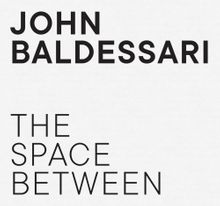| ||||||||||||||||||||||||||||||
ARTIST MONOGRAPHS
|
|
in stock $45.00 Free Shipping UPS GROUND IN THE CONTINENTAL U.S. |
 John Baldessari
John Baldessari
Published by Walther König, Köln.
Edited with text by Matilda Olof-Ors. Text by John Baldessari, Ann-Sofi Noring, Gitte Řrskou.
Over the course of his 50-year career, John Baldessari never stopped exploring the seemingly infinite ways that words and images can be manipulated to create new layers of narrative meaning in art. Initially a more traditional painter, in the 1960s Baldessari found himself drawn to a combination of text and photography as the most effective vehicles for his creative intentions. Many of Baldessari’s pieces directly address the viewer with hand-painted questions about the nature of art: in What Is Painting (1966-68), Baldessari asks through the canvas, “Do you sense how all the parts of a good picture are involved with each other, not just placed side by side” This piece in particular seems to summarize Baldessari’s focus on the recontextualization of familiar images that would define his artistic practice for years to come.
Alongside reproductions of select work, this publication features a wide selection of Baldessari’s own writings from 1968 to 2011, providing further insight into the myriad critical ideas already conveyed in the artist’s work.Born in California, John Baldessari (1931-2020) was one of the most influential artists of the conceptual and post-conceptual movements. Baldessari taught at CalArts from 1970 to 1986 and then at UCLA until 2008, with artists such as David Salle and Mike Kelley as some of his earliest students. His commitment to “not making boring art” is evident throughout his entire oeuvre.
PUBLISHER
Walther König, Köln
BOOK FORMAT
Paperback, 8.5 x 11.25 in. / 128 pgs / 50 color.
PUBLISHING STATUS
Pub Date 8/18/2020
Active
DISTRIBUTION
D.A.P. Exclusive
Catalog: FALL 2020 p. 62
PRODUCT DETAILS
ISBN 9783960987956 TRADE
List Price: $39.95 CAD $55.95
AVAILABILITY
Out of stock
STATUS: Out of stock Temporarily out of stock pending additional inventory. |
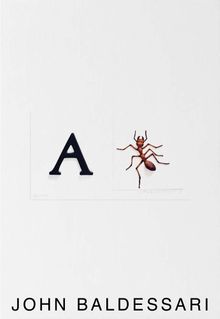 Learning to Read with John Baldessari
Learning to Read with John Baldessari
Published by JRP|Ringier.
Edited by Kit Hammonds. Text by Ashley Bickerton, Liz Craft, Meg Cranston, Julieta González, Kit Hammonds, Matt Mullican, Tony Oursler, David Salle, James Welling.
As ludic and nonauthoritarian as John Baldessari’s art, this new monograph on the “father of conceptual art” is dedicated to his practice as an artist and a teacher, and the many ways in which they intertwine. Having been trained as an arts educator, John Baldessari (born 1931) is renowned for his work as much as for his innovative class at CalArts, Los Angeles, where he has formed many generations of artists and helped shape the West Coast art scene. Organized alphabetically, Learning to Read with John Baldessari—which accompanies a retrospective at Museo Jumex, Mexico City—includes an essay on the artist’s approaches to art-making and teaching; a biography of the artist as a teacher; artworks reproduced thematically; and stories and anecdotes from former students such as Liz Craft, Ed Henderson, Matt Mullican, Tony Oursler and David Salle, about their years at CalArts.
PUBLISHER
JRP|Ringier
BOOK FORMAT
Hardcover, 9 x 11 in. / 312 pgs / 66 color / 91 bw.
PUBLISHING STATUS
Pub Date 2/27/2018
Out of print
DISTRIBUTION
D.A.P. Exclusive
Catalog: SPRING 2018 p. 173
PRODUCT DETAILS
ISBN 9783037645185 TRADE
List Price: $60.00 CAD $79.00
AVAILABILITY
Not available
STATUS: Out of print | 00/00/00 For assistance locating a copy, please see our list of recommended out of print specialists |
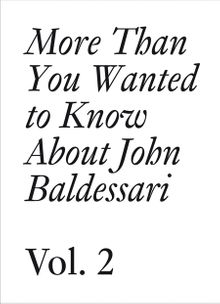 More Than You Wanted to Know About John Baldessari
More Than You Wanted to Know About John Baldessari
Volume II
Published by JRP|Ringier.
Edited by Meg Cranston, Hans Ulrich Obrist.
PUBLISHER
JRP|Ringier
BOOK FORMAT
Paperback, 6 x 8.25 in. / 250 pgs / 15 color.
PUBLISHING STATUS
Pub Date 9/30/2013
Active
DISTRIBUTION
D.A.P. Exclusive
Catalog: SPRING 2013 p. 155
PRODUCT DETAILS
ISBN 9783037642566 TRADE
List Price: $29.95 CAD $39.95 GBP £15.00
AVAILABILITY
In stock
in stock $29.95 Free Shipping UPS GROUND IN THE CONTINENTAL U.S. |
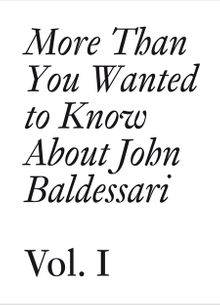 More Than You Wanted to Know About John Baldessari
More Than You Wanted to Know About John Baldessari
Volume 1
Published by JRP|Ringier.
Edited by Meg Cranston, Hans Ulrich Obrist.
PUBLISHER
JRP|Ringier
BOOK FORMAT
Paperback, 6 x 8.25 in. / 250 pgs / 15 bw.
PUBLISHING STATUS
Pub Date 11/30/2013
Active
DISTRIBUTION
D.A.P. Exclusive
Catalog: SPRING 2012 p. 98
PRODUCT DETAILS
ISBN 9783037641927 TRADE
List Price: $29.95 CAD $39.95 GBP £15.00
AVAILABILITY
In stock
in stock $29.95 Free Shipping UPS GROUND IN THE CONTINENTAL U.S. |
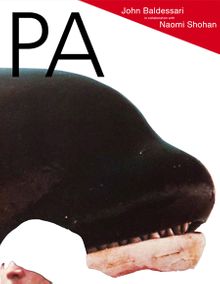 PA: John Baldessari in Collaboration with Naomi Shohan
PA: John Baldessari in Collaboration with Naomi Shohan
Published by JRP|Ringier.
Edited by Cristina Bechtler, David Campany. Text by John Baldessari, David Campany, Amy Cappellazzo, Jessica Morgan, Naomi Shohan.
PUBLISHER
JRP|Ringier
BOOK FORMAT
Paperback, 9.5 x 12.25 in. / 127 pgs / 100 color.
PUBLISHING STATUS
Pub Date 4/30/2012
Active
DISTRIBUTION
D.A.P. Exclusive
Catalog: SPRING 2012 p. 98
PRODUCT DETAILS
ISBN 9783037642528 TRADE
List Price: $29.00 CAD $39.50 GBP £15.00
AVAILABILITY
In stock
in stock $29.00 Free Shipping UPS GROUND IN THE CONTINENTAL U.S. |
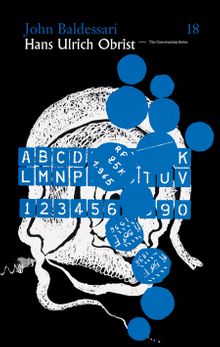 Hans Ulrich Obrist & John Baldessari: The Conversation Series Volume 18
Hans Ulrich Obrist & John Baldessari: The Conversation Series Volume 18
Published by Walther König, Köln.
Edited by Hans Ulrich Obrist.
PUBLISHER
Walther König, Köln
BOOK FORMAT
Paperback, 5.5 x 8.5 in. / 242 pgs / 20 bw.
PUBLISHING STATUS
Pub Date 2/28/2010
Active
DISTRIBUTION
D.A.P. Exclusive
Catalog: SPRING 2010 p. 76
PRODUCT DETAILS
ISBN 9783865605009 TRADE
List Price: $26.00 CAD $36.00
AVAILABILITY
In stock
in stock $26.00 Free Shipping UPS GROUND IN THE CONTINENTAL U.S. |
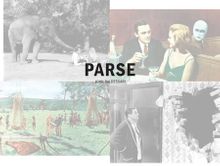 John Baldessari: Parse
John Baldessari: Parse
Published by JRP|Ringier.
Edited by Beatrix Ruf.
PUBLISHER
JRP|Ringier
BOOK FORMAT
Hardcover, 13 x 10 in. / 312 pgs / 300 color.
PUBLISHING STATUS
Pub Date 8/31/2010
Active
DISTRIBUTION
D.A.P. Exclusive
Catalog: FALL 2010 p. 91
PRODUCT DETAILS
ISBN 9783037641170 TRADE
List Price: $95.00 CAD $127.50 GBP £48.00
AVAILABILITY
Out of stock
STATUS: Out of stock Temporarily out of stock pending additional inventory. |
 John Baldessari: Brick Bldg, Lg Windows W/Xlent Views, Partially Furnished, Renowned Architect
John Baldessari: Brick Bldg, Lg Windows W/Xlent Views, Partially Furnished, Renowned Architect
Published by Kerber.
Edited by Martin Hentschel. Text by John C. Welchman.
PUBLISHER
Kerber
BOOK FORMAT
Hardcover, 11.25 x 8.5 in. / 136 pgs / 75 color / 14 bw.
PUBLISHING STATUS
Pub Date 6/30/2010
Out of print
DISTRIBUTION
D.A.P. Exclusive
Catalog: SPRING 2010 p. 128
PRODUCT DETAILS
ISBN 9783866783065 TRADE
List Price: $45.00 CAD $60.00
AVAILABILITY
Not available
STATUS: Out of print | 00/00/00 For assistance locating a copy, please see our list of recommended out of print specialists |
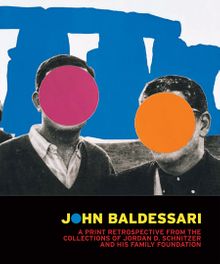 John Baldessari: A Print Retrospective from the Collections of Jordan D. Schnitzer and his Family Foundation
John Baldessari: A Print Retrospective from the Collections of Jordan D. Schnitzer and his Family Foundation
Published by Fine Arts Museums of San Francisco-Legion of Honor/Jordan Schnitzer Family.
Text by Hunter Drohojowska-Philip.
PUBLISHER
Fine Arts Museums of San Francisco-Legion of Honor/Jordan Schnitzer Family
BOOK FORMAT
Clth, 10 x 12 in. / 160 pgs / 140 color.
PUBLISHING STATUS
Pub Date 4/30/2010
Out of stock indefinitely
DISTRIBUTION
D.A.P. Exclusive
Catalog: SPRING 2010 p. 91
PRODUCT DETAILS
ISBN 9781935202103 TRADE
List Price: $59.95 CAD $79.00 GBP £52.99
AVAILABILITY
Not available
STATUS: Out of stock indefinitely. |
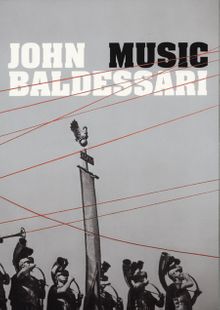 John Baldessari: Music
John Baldessari: Music
Published by Walther König, Köln.
Edited by John C. Welchman, Stefan Gronert, Christina Vegh.
PUBLISHER
Walther König, Köln
BOOK FORMAT
Paperback, 8.25 x 11 in. / 144 pgs / 82 color / 73 bw.
PUBLISHING STATUS
Pub Date 1/15/2008
Out of print
DISTRIBUTION
D.A.P. Exclusive
Catalog: SPRING 2008 p. 149
PRODUCT DETAILS
ISBN 9783865602480 TRADE
List Price: $48.00 CAD $60.00
AVAILABILITY
Not available
STATUS: Out of print | 00/00/00 For assistance locating a copy, please see our list of recommended out of print specialists |
 John Baldessari & Alejandro Cesarco: Retrospective
John Baldessari & Alejandro Cesarco: Retrospective
Published by Walther König, Köln.
PUBLISHER
Walther König, Köln
BOOK FORMAT
Paperback, 6 x 8.5 in. / 24 pgs / 12 color.
PUBLISHING STATUS
Pub Date 3/1/2008
Out of print
DISTRIBUTION
D.A.P. Exclusive
Catalog: SPRING 2008 p. 149
PRODUCT DETAILS
ISBN 9783865603449 FLAT40
List Price: $19.95 CAD $27.95
AVAILABILITY
Not available
STATUS: Out of print | 00/00/00 For assistance locating a copy, please see our list of recommended out of print specialists |
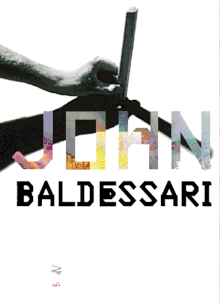 John Baldessari: Films Transferred to Video 1972-1977
John Baldessari: Films Transferred to Video 1972-1977
Published by JRP|Ringier/BDV Bureau des videos.
Edited by Nicolas Trembley.
PUBLISHER
JRP|Ringier/BDV Bureau des videos
BOOK FORMAT
DVD video, PAL Multizone, 5.5 x 7.5 in.
PUBLISHING STATUS
Pub Date 3/1/2007
Out of print
DISTRIBUTION
D.A.P. Exclusive
Catalog: SPRING 2007 p. 130
PRODUCT DETAILS
ISBN 9783905770094 TRADE
List Price: $45.00 CAD $55.00
AVAILABILITY
Not available
STATUS: Out of print | 11/25/2008 For assistance locating a copy, please see our list of recommended out of print specialists |
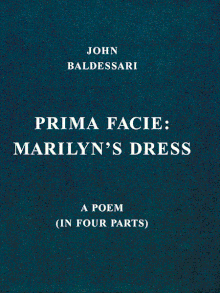 John Baldessari: Prima Facie
John Baldessari: Prima Facie
Marilyn's Dress
Published by Walther König, Köln.
PUBLISHER
Walther König, Köln
BOOK FORMAT
Hardcover, 6.5 x 12.25 in. / 44 pgs / 16 color.
PUBLISHING STATUS
Pub Date 2/1/2007
Out of print
DISTRIBUTION
D.A.P. Exclusive
Catalog: SPRING 2007 p. 152
PRODUCT DETAILS
ISBN 9783865600882 TRADE
List Price: $35.00 CAD $47.50
AVAILABILITY
Not available
STATUS: Out of print | 00/00/00 For assistance locating a copy, please see our list of recommended out of print specialists |
 John Baldessari: A Different Kind Of Order
John Baldessari: A Different Kind Of Order
Published by Walther König, Köln.
Edited by Edelbert Kŕb and Peter Pakesch. Essays by Rainer Fuchs, Matt Mullican, Anne Rorimer, Marie de Brugerolle, Winfried Pauleit, Hans Dieter Huber, Klaus Hoffer, Gertrud Koch, Ann Goldstein and Christopher Williams.
PUBLISHER
Walther König, Köln
BOOK FORMAT
Paperback, 8.75 x 11 in. / 278 pgs / 250 color / 40 bw
PUBLISHING STATUS
Pub Date 6/15/2005
Out of print
DISTRIBUTION
D.A.P. Exclusive
Catalog: FALL 2005 p. 170
PRODUCT DETAILS
ISBN 9783883759388 SDNR30
List Price: $50.00 CAD $60.00
AVAILABILITY
Not available
STATUS: Out of print | 5/23/2006 For assistance locating a copy, please see our list of recommended out of print specialists |
 John Baldessari: Life's Balance 1984-2004
John Baldessari: Life's Balance 1984-2004
Published by Walther König, Köln.
Artwork by John Baldessari.
PUBLISHER
Walther König, Köln
BOOK FORMAT
Hardcover, 8.75 x 11 in. / 200 pgs / 120 color / 80 bw
PUBLISHING STATUS
Pub Date 6/15/2005
Out of print
DISTRIBUTION
D.A.P. Exclusive
Catalog: FALL 2005 p. 170
PRODUCT DETAILS
ISBN 9783883759371 SDNR30
List Price: $45.00 CAD $55.00
AVAILABILITY
Not available
STATUS: Out of print | 5/23/2006 For assistance locating a copy, please see our list of recommended out of print specialists |
 John Baldessari
John Baldessari
Published by Guggenheim Museum Publications.
Essays by Tracey Bashkoff, John Hanhardt, Frederic Tuten and Russell Ferguson.
PUBLISHER
Guggenheim Museum Publications
BOOK FORMAT
Hardcover, 9 x 11 in. / 112 pgs / 65 color.
PUBLISHING STATUS
Pub Date 1/2/2005
Out of print
DISTRIBUTION
D.A.P. Exclusive
Catalog: FALL 2004
PRODUCT DETAILS
ISBN 9780892073177 TRADE
List Price: $40.00 CAD $50.00
AVAILABILITY
Not available
STATUS: Out of print | 11/28/2010 For assistance locating a copy, please see our list of recommended out of print specialists |
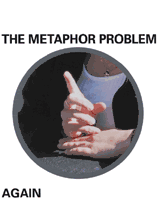 John Baldessari & Lawrence Weiner: The Metaphor Problem Again
John Baldessari & Lawrence Weiner: The Metaphor Problem Again
Published by Walther König, Köln.
Artwork by John Baldessari, Lawrence Weiner.
PUBLISHER
Walther König, Köln
BOOK FORMAT
Paperback, 5.5 x 7.25 in. / 72 pgs / 28 duotone
PUBLISHING STATUS
Pub Date 3/2/2000
No longer our product
DISTRIBUTION
D.A.P. Exclusive
Catalog: SPRING 2000
PRODUCT DETAILS
ISBN 9783883754048 SDNR30
List Price: $35.00 CAD $40.00
AVAILABILITY
 John Baldessari: While Something Is Happening Here, Something Else Is Happening There
John Baldessari: While Something Is Happening Here, Something Else Is Happening There
Works 1988-1999
Published by Walther König, Köln.
Contributions by Meg Cranston, Diedrich Diederichsen, Thomas Weski.
PUBLISHER
Walther König, Köln
BOOK FORMAT
Hardcover, 8.75 x 11.25 in. / 124 pgs / 49 color
PUBLISHING STATUS
Pub Date 3/2/2000
No longer our product
DISTRIBUTION
D.A.P. Exclusive
Catalog: SPRING 2000
PRODUCT DETAILS
ISBN 9783883753966 SDNR30
List Price: $30.00 CAD $35.00
AVAILABILITY
PUBLISHER
Oktagon
BOOK FORMAT
Paperback, 6 x 4 in. / 152 pgs / 77 bw
PUBLISHING STATUS
Pub Date 2/2/1999
No longer our product
DISTRIBUTION
D.A.P. Exclusive
Catalog: SPRING 1999
PRODUCT DETAILS
ISBN 9783896110459 SDNR30
List Price: $45.00 CAD $55.00
AVAILABILITY
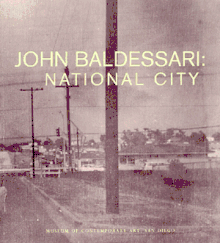 John Baldessari: National City
John Baldessari: National City
Published by Museum of Contemporary Art, San Diego.
Artwork by John Baldessari. Contributions by Andrea Hales. Text by Hugh Davies, Anne Rorimer.
PUBLISHER
BOOK FORMAT
Paperback, 8.75 x 10 in. / 112 pgs / 33 color / 12 bw / 28 duotone
PUBLISHING STATUS
Pub Date 2/2/1997
Out of print
DISTRIBUTION
D.A.P. Exclusive
Catalog: SPRING 1997
PRODUCT DETAILS
ISBN 9780934418492 TRADE
List Price: $24.95 CAD $27.50
AVAILABILITY
Not available
STATUS: Out of print | 12/19/2005 For assistance locating a copy, please see our list of recommended out of print specialists |
